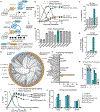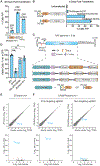Brainwide silencing of prion protein by AAV-mediated delivery of an engineered compact epigenetic editor
- PMID: 38935715
- PMCID: PMC11875203
- DOI: 10.1126/science.ado7082
Brainwide silencing of prion protein by AAV-mediated delivery of an engineered compact epigenetic editor
Abstract
Prion disease is caused by misfolding of the prion protein (PrP) into pathogenic self-propagating conformations, leading to rapid-onset dementia and death. However, elimination of endogenous PrP halts prion disease progression. In this study, we describe Coupled Histone tail for Autoinhibition Release of Methyltransferase (CHARM), a compact, enzyme-free epigenetic editor capable of silencing transcription through programmable DNA methylation. Using a histone H3 tail-Dnmt3l fusion, CHARM recruits and activates endogenous DNA methyltransferases, thereby reducing transgene size and cytotoxicity. When delivered to the mouse brain by systemic injection of adeno-associated virus (AAV), Prnp-targeted CHARM ablates PrP expression across the brain. Furthermore, we have temporally limited editor expression by implementing a kinetically tuned self-silencing approach. CHARM potentially represents a broadly applicable strategy to suppress pathogenic proteins, including those implicated in other neurodegenerative diseases.
Conflict of interest statement
Competing interests:
J.S.W. declares outside interest in 5 AM Venture, Amgen, Chroma Medicine, KSQ Therapeutics, Maze Therapeutics, Tenaya Therapeutics, Tessera Therapeutics, Ziada Therapeutics and Third Rock Ventures. S.M.V. acknowledges speaking fees from Ultragenyx, Illumina, Biogen, Eli Lilly; consulting fees from Invitae and Alnylam; research support from Ionis, Gate, Sangamo. E.V.M. acknowledges speaking fees from Eli Lilly; consulting fees from Deerfield and Alnylam; research support from Ionis, Gate, Sangamo, and Eli Lilly. A.S.K. is a scientific advisor for and holds equity in Senti Biosciences and Chroma Medicine, and is a co-founder of Fynch Biosciences and K2 Biotechnologies. E.N.N., T.M.B., and J.S.W. are co-inventors on U.S. patent application no. 18/444,590 filed by the Whitehead Institute, relating to CHARM and self-silencing AAVs. E.N.N, T.M.B., J.S.W., E.V.M., and S.M.V. are co-inventors on provisional U.S. patent application no. 63/623,787 filed jointly by the Whitehead Institute and Broad Institute relating to ZFcharms for prion disease. B.E.D. declares outside interest in Apertura Gene Therapy and Tevard Biosciences and is an inventor on U.S. patent application no. US11499165B2 relating to the PHP.eB AAV capsid. All other authors declare that they have no competing interests.
Figures






Comment in
-
An epigenetic editor to silence genes.Science. 2024 Jun 28;384(6703):1407-1408. doi: 10.1126/science.adq3334. Epub 2024 Jun 27. Science. 2024. PMID: 38935735
-
Epigenetic editor silences prion protein.Nat Rev Drug Discov. 2024 Sep;23(9):660. doi: 10.1038/d41573-024-00128-x. Nat Rev Drug Discov. 2024. PMID: 39054397 No abstract available.
References
-
- Vallabh SM, Minikel EV, Schreiber SL, Lander ES, Towards a treatment for genetic prion disease: trials and biomarkers. Lancet Neurol 19, 361–368 (2020). - PubMed
-
- Maddox RA, Person MK, Blevins JE, Abrams JY, Appleby BS, Schonberger LB, Belay ED, Prion disease incidence in the United States: 2003–2015. Neurology 94, e153–e157 (2020). - PubMed
-
- Büeler A. Aguzzi, Sailer A, Greiner RA, Autenried P, Aguet M, Weissmann C, Mice devoid of PrP are resistant to scrapie. Cell 73, 1339–1347 (1993). - PubMed
-
- Mallucci G, Dickinson A, Linehan J, Klöhn PC, Brandner S, Collinge J, Depleting Neuronal PrP in Prion Infection Prevents Disease and Reverses Spongiosis. Science 302, 871–874 (2003). - PubMed
Publication types
MeSH terms
Substances
Grants and funding
LinkOut - more resources
Full Text Sources
Other Literature Sources
Molecular Biology Databases
Research Materials

